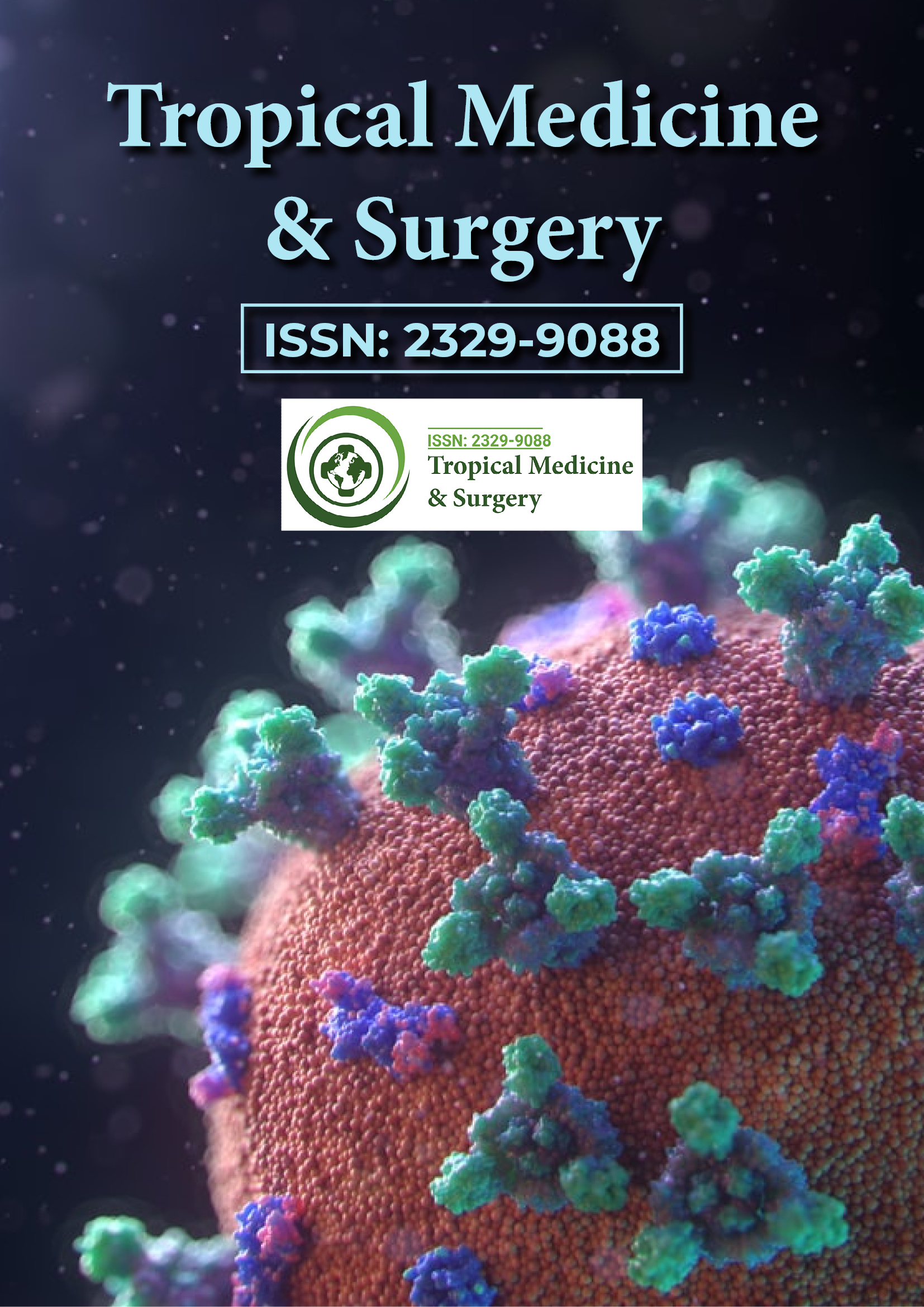Indexed In
- Open J Gate
- Academic Keys
- RefSeek
- Hamdard University
- EBSCO A-Z
- OCLC- WorldCat
- Publons
- Euro Pub
- Google Scholar
Useful Links
Share This Page
Journal Flyer

Open Access Journals
- Agri and Aquaculture
- Biochemistry
- Bioinformatics & Systems Biology
- Business & Management
- Chemistry
- Clinical Sciences
- Engineering
- Food & Nutrition
- General Science
- Genetics & Molecular Biology
- Immunology & Microbiology
- Medical Sciences
- Neuroscience & Psychology
- Nursing & Health Care
- Pharmaceutical Sciences
Opinion Article - (2024) Volume 12, Issue 3
Glycosylation as a Modulator of Antibody Response in Lyme Disease Patients
Aris Calvin*Received: 26-Aug-2024, Manuscript No. TPMS-24-27032; Editor assigned: 28-Aug-2024, Pre QC No. TPMS-24-27032 (PQ); Reviewed: 11-Sep-2024, QC No. TPMS-24-27032; Revised: 18-Sep-2024, Manuscript No. TPMS-24-27032 (R); Published: 26-Sep-2024, DOI: 10.35248/2329-9088.24.12.365
Description
Lyme disease, caused by the bacterium Borrelia burgdorferi and transmitted through tick bites, presents with a range of clinical manifestations, from localized skin lesions to systemic complications. An effective immune response is essential for combating this infection and Immunoglobulins (Ig), particularly IgM and IgG, play a key role in recognizing and neutralizing pathogens.
Glycosylation and immunoglobulins
Glycosylation is a post-translational modification where sugar molecules are added to proteins. This modification influences the structure, function and stability of proteins, including immunoglobulins. In the immune system, glycosylation affects antibody functionality, such as antigen recognition and immune cell activation.
Immunoglobulins, particularly IgG, have glycosylation patterns that can vary based on genetic and environmental factors. These variations can influence the antibody's ability to bind to antigens and engage with immune cells effectively. In the context of Lyme disease, understanding how glycosylation affects immunoglobulins provides insight into the immune system's response to Borrelia burgdorferi.
Glycosylation patterns and immune response
The glycosylation of immunoglobulins includes the addition of various sugar moieties, such as N-Acetylglucosamine (GlcNAc) and mannose. These sugar residues can alter the antibody's interaction with other immune system components, including Fc receptors on immune cells and complement proteins.
In acute Lyme disease, the body's initial immune response involves the production of specific antibodies against Borrelia burgdorferi. The glycosylation patterns of these antibodies can affect their ability to bind to the bacterial antigens and facilitate their clearance. For instance, alterations in glycosylation may reduce the efficacy of Antibody-Dependent Cellular Cytotoxicity (ADCC) or complement-mediated bacterial lysis.
Impact of glycosylation on acute lyme disease
Studies have shown that host glycosylation can significantly influence the course of Lyme disease. In individuals with acute Lyme disease, the glycosylation patterns of immunoglobulins can impair their effectiveness in several ways.
Reduced binding affinity: Glycosylation can impact the binding affinity of antibodies to Borrelia burgdorferi. Abnormal glycosylation may lead to a reduced ability of antibodies to bind to the bacterial surface antigens, thus impairing the initial immune response.
Impaired antibody function: Glycosylation affects the functional aspects of antibodies, such as their ability to activate complement pathways or engage with Fc receptors on immune cells. In acute Lyme disease, altered glycosylation patterns may decrease the efficiency of these processes, allowing the bacteria to persist longer in the host.
Altered immune cell interaction: The interaction between antibodies and immune cells is essential for an effective immune response. Glycosylation changes can affect how antibodies interact with immune cells like macrophages and natural killer cells, potentially leading to a less effective clearance of the infection.
Clinical implications of altered glycosylation
Understanding the impact of glycosylation on immunoglobulins in acute Lyme disease has several clinical implications.
Diagnostic biomarkers: Identifying specific glycosylation patterns in immunoglobulins could serve as biomarkers for diagnosing acute Lyme disease or assessing disease severity. For instance, detecting aberrant glycosylation profiles in IgG antibodies might help in distinguishing acute Lyme disease from other similar conditions.
Predicting disease progression: Understanding glycosylation patterns may help predict disease outcomes. For example, patients with specific glycosylation changes might be at higher risk of prolonged or severe Lyme disease, enabling earlier and more targeted interventions.
Therapeutic interventions: Research into glycosylation could lead to new therapeutic strategies. For example, developing treatments that correct abnormal glycosylation patterns or enhance antibody function might improve the effectiveness of existing Lyme disease therapies. Additionally, glycosylation- modulating drugs could potentially boost the immune response in patients with chronic or persistent Lyme disease.
Personalized medicine: By understanding individual variations in glycosylation, personalized approaches to treatment may be developed. Tailoring interventions based on a patient's specific glycosylation profile could enhance treatment outcomes and reduce the duration of symptoms.
Recent research has explored the relationship between immunoglobulin glycosylation and the progression of acute Lyme disease. Studies have identified specific glycosylation patterns associated with impaired immune responses. For example, researchers have found that patients with acute Lyme disease often exhibit altered glycosylation patterns in their IgG antibodies, which correlate with a decreased ability to mount an effective immune response.
Patients with acute Lyme disease, IgG antibodies displayed a reduced presence of certain sugar residues that are essential for optimal immune function. This alteration in glycosylation was associated with prolonged symptoms and a higher likelihood of persistent infection.
Mechanisms of glycosylation changes
Investigating the underlying mechanisms that lead to altered glycosylation patterns in Lyme disease could provide deeper insights into the disease process and potential intervention points.
Therapeutic development
Research into drugs or therapies that target glycosylation pathways or enhance antibody function may offer new avenues for treatment. Developing agents that can correct or optimize glycosylation patterns might improve immune responses and patient outcomes.
Broader implications
Examining how glycosylation affects immune responses in other infectious diseases could expand the understanding of this phenomenon and its potential impact on a wider range of conditions.
Citation: Calvin A (2024). Glycosylation as a Modulator of Antibody Response in Lyme Disease Patients. Trop Med Surg. 12:365.
Copyright: © 2024 Calvin A. This is an open-access article distributed under the terms of the Creative Commons Attribution License, which permits unrestricted use, distribution, and reproduction in any medium, provided the original author and source are credited.
